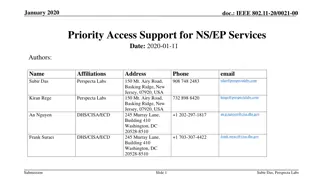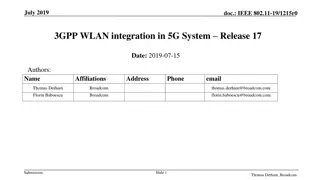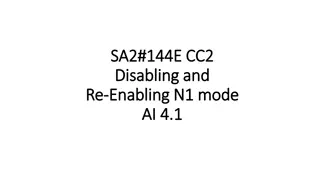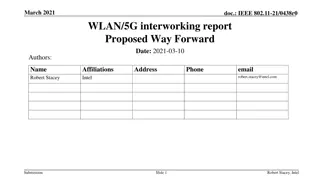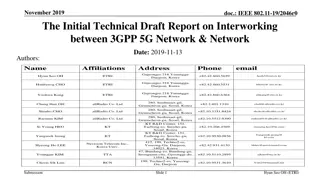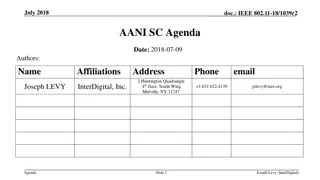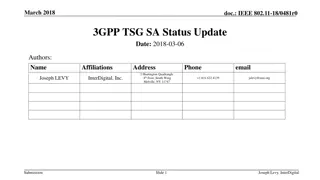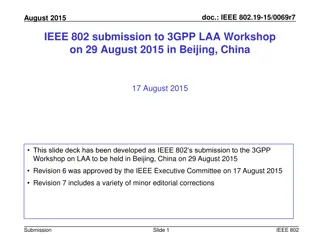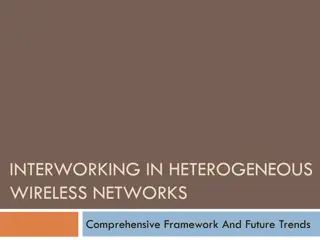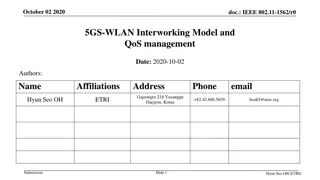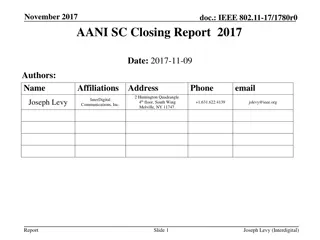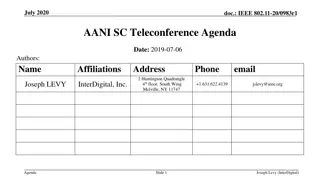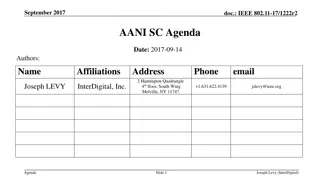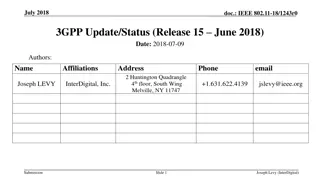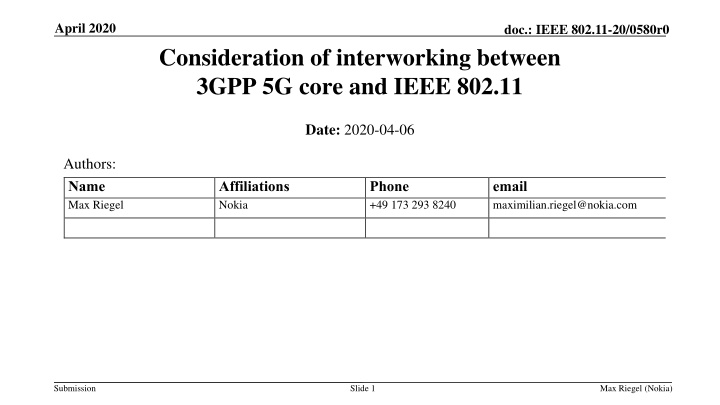
Interworking Considerations Between IEEE 802.11 and 5G Core Networks
Explore the potential standardization demand in IEEE 802.11 for interworking with 5G QoS models and signaling. This presentation discusses trusted WLAN interworking scenarios and the need to consider new 5G services like URLLC and eMTC. Insights into enhancements for low-latency communications and interworking issues with 5G core are also highlighted.
Download Presentation

Please find below an Image/Link to download the presentation.
The content on the website is provided AS IS for your information and personal use only. It may not be sold, licensed, or shared on other websites without obtaining consent from the author. If you encounter any issues during the download, it is possible that the publisher has removed the file from their server.
You are allowed to download the files provided on this website for personal or commercial use, subject to the condition that they are used lawfully. All files are the property of their respective owners.
The content on the website is provided AS IS for your information and personal use only. It may not be sold, licensed, or shared on other websites without obtaining consent from the author.
E N D
Presentation Transcript
April 2020 doc.: IEEE 802.11-20/0580r0 Consideration of interworking between 3GPP 5G core and IEEE 802.11 Date: 2020-04-06 Authors: Name Max Riegel Affiliations Nokia Phone +49 173 293 8240 email maximilian.riegel@nokia.com Submission Slide 1 Max Riegel (Nokia)
April 2020 doc.: IEEE 802.11-20/0580r0 Abstract The presentation introduces potential standardization demand in IEEE 802.11 regarding interworking with 5G QoS model and 5G QoS signalling and proposes to consider trusted WLAN interworking scenario in addition to the commonly assumed untrusted scenario. Submission Slide 2 Max Riegel (Nokia)
April 2020 doc.: IEEE 802.11-20/0580r0 Motivation Rationales for AANI SC 5G WLAN Interworking report IEEE 802.11 is widely used for early introduction of 5G-like services demanding high throughput and high capacity 5G provides not only higher capacity and throughput but also new kind of services (URLLC, eMTC) that haven t considered yet for interworking with IEEE 802.11 P802.11be considers enhancements to QoS that would allow for 5G services beyond prioritized best effort communication, e.g. low latency communications. Design decisions in P802.11be could benefit from insights into interworking issues with 5G core. The slides provide thoughts in addition to the content already covered in Draft technical report on interworking between 3GPP 5G network & WLAN May trigger discussions leading to further revisions of the draft report Submission Slide 3 Max Riegel (Nokia)
April 2020 doc.: IEEE 802.11-20/0580r0 5G Qos Model 5G QoS characteristics is defined through: 1 Resource Type (GBR, Delay critical GBR or Non-GBR); 2 Priority Level; 3 Packet Delay Budget; 4 Packet Error Rate; 5 Averaging window (for GBR and Delay-critical GBR resource type only); 6 Maximum Data Burst Volume (for Delay- critical GBR resource type only). Application /Service Layer Data packets from applications QoS rules (mapping UL packets to QoS flows and apply QoS flow marking) QoS Flow (all packets marked with the same QFI) PDRs Mapping QoS flows to AN Resources AN Resources (classify packets for QoS flow marking and other actions) PDU Session UPF UE AN 3GPP TS 23.501 Figure 5.7.1.5-1: The principle for classification and User Plane marking for QoS Flows and mapping to AN Resources Submission Slide 4 Max Riegel (Nokia)
April 2020 doc.: IEEE 802.11-20/0580r0 5G QoS Signaling QoS signaling (establishment, maintenance, and teardown of service flows) is part of NAS (Non-Access-Stratum) protocol In 5G NAS procedures are used for: 5GS mobility management (5GMM) protocol for the control of mobility within NG radio access network (NG-RAN) and/or non-3GPP access network. Also provides control of security for the NAS protocols. 5GS session management (5GSM) protocol for the handling of 5GS PDU sessions. Control of user-plane resources together with the bearer control provided by the access stratum A 5GS session management (5GSM) message is piggybacked in specific 5GS mobility management (5GMM) transport messages. The UE can only initiate the 5GSM procedure when there is a 5GMM context established at the UE. Submission Slide 5 Max Riegel (Nokia)
April 2020 doc.: IEEE 802.11-20/0580r0 Potential IEEE 802.11 standardization topics for 5G QoS support Current IEEE 802.11 does not provide full support of 5G QoS model How to realize and handle QoS flows over IEEE 802.11? Which 5G QoS classes could be supported by IEEE 802.11ax? Which by P802.11be? There is no equivalent to the 5GSM in IEEE 802.11 Currently realized OTT through 5G-EAP/IKEv2/IPsec How to interface into the IEEE 802.11 access stratum ? Submission Slide 6 Max Riegel (Nokia)
April 2020 doc.: IEEE 802.11-20/0580r0 3GPP 5G Untrusted WLAN Interworking Scenario N2 N11 3GPP Access AMF SMF N3 N2 N4 N1 Data Network N3IWF UPF N3 N6 HPLMN NWu Y2 N1 Non-3GPP Networks Untrusted Non- 3GPP Access UE Y1 3GPP TS 23.501 Figure 4.2.8.2.1-1: Non-roaming architecture for 5G Core Network with untrusted non-3GPP access Untrusted scenario is most commonly assumed for WLAN interworking with N1 carrying NAS protocol, and NWu representing 5G EAP/IKEv2/IPsec Submission Slide 7 Max Riegel (Nokia)
April 2020 doc.: IEEE 802.11-20/0580r0 3GPP 5G Trusted WLAN Interworking Scenario N2 N11 3GPP Access AMF SMF N1 N3 N1 N2 N4 Data Network UPF N6 HPLMN N3 Trusted Non-3GPP Access Point Trusted Non-3GPP Gateway Function UE Tn NWt Ta Yt TNAP TNGF Trusted Non-3GPP Access Network (TNAN) 3GPP TS 23.501 Figure 4.2.8.2.1-2: Non-roaming architecture for 5G Core Network with trusted non-3GPP access Trusted model could be deployed by mobile operators owning their WLAN access, but also for private 5G deployments e.g industrial use cases. Submission Slide 8 Max Riegel (Nokia)
April 2020 doc.: IEEE 802.11-20/0580r0 Conclusion It makes sense to create a report on interworking between 3GPP 5G core and IEEE 802.11 to facilitate better integration of Wi-Fi with 5G. Identified missing functionalities could be addressed in P802.11be or also in new IEEE 802.11 standardization projects. Further investigations and documentation required on adaptation of IEEE 802.11 to 3GPP 5G QoS model and QoS signalling. Trusted interworking model should be considered in addition to untrusted model, in particular when enabling industrial use cases. Submission Slide 9 Max Riegel (Nokia)



